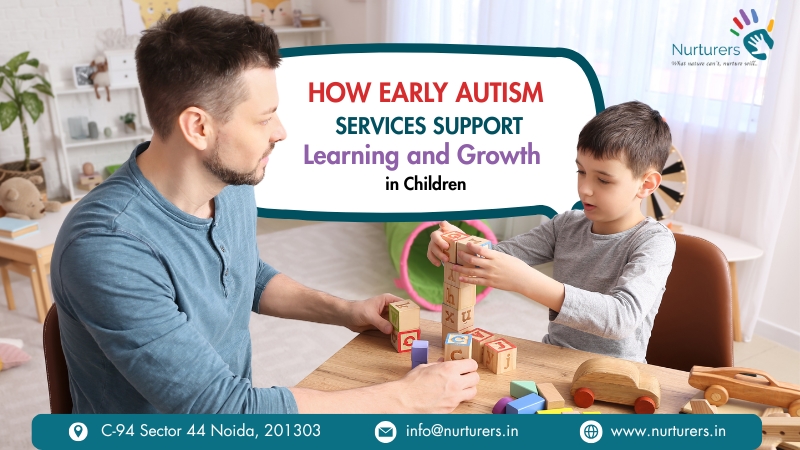When autism is identified early in life, it opens up the opportunity to intervene during the most critical stages of brain development. Early autism services are designed to support young children showing signs of Autism Spectrum Disorder (ASD) by providing therapies that enhance learning, communication, behavior, and emotional regulation. These services are often life-changing—not just for the child but for their family too.
Recognizing the early signs of autism and seeking timely intervention can help children build the foundational skills needed for school, relationships, and everyday life. In this blog, we’ll explore how early intervention works, its benefits, and the therapy strategies that promote positive development.
What Is Early Intervention For Autism?
Early intervention for autism refers to specialized support services provided to children usually under the age of six who show developmental delays or signs of autism. These services aim to address challenges related to communication, social interaction, play skills, and behavior before they become more deeply rooted.
According to pediatric and neurological experts, the earlier a child begins therapy, the better their long-term developmental outcomes. Early intervention is often coordinated through a team of professionals, including speech therapists, occupational therapists, developmental pediatricians, behavioral therapists, and psychologists.
Key goals of early intervention:
- Improve communication (verbal and non-verbal)
- Promote emotional regulation and attention span
- Enhance social and play skills
- Support cognitive development
- Empower parents through training and involvement

Symptoms of Early Intervention
While “early intervention” itself doesn’t have symptoms, certain developmental red flags in young children suggest that they may benefit from it. Identifying these early signs—especially within the first three years of life—is crucial for starting effective autism therapy services as soon as possible.
Recognizing the early signs of autism can help parents and caregivers seek support before developmental gaps widen.
Common Early Signs of Autism That May Indicate the Need for Intervention:
- Delayed speech or no babbling by 12 months
Children may not say simple words like “mama” or “dada” or may show very limited vocal play. - No response to name by 9–12 months
Even after multiple attempts, the child may not turn toward their name being called. - Limited eye contact or facial expressions
A lack of eye engagement during play or feeding, and minimal smiling or sharing of facial expressions. - Repetitive movements
Behaviors like hand-flapping, rocking, spinning, or toe-walking that are repeated frequently and without clear purpose. - Lack of interest in social interaction
Preferring to play alone, avoiding peer interaction, or showing no desire to share enjoyment or objects with others. - Strong attachment to routines
Becoming upset over small changes in routine, environment, or daily schedule, such as a different meal plate or route home. - Unusual sensory responses
Either overreacting (covering ears for everyday sounds) or underreacting (ignoring loud noises), and being unusually fascinated with lights, textures, or spinning objects. - Limited gestures or pointing by 12–15 months Children may not wave goodbye, point to objects of interest, or reach to be picked up.

Benefits of Early Intervention In Autism
Early autism services can significantly improve a child’s ability to learn, communicate, and adapt. Starting therapy during the early years—when the brain is still developing—helps children build strong foundations that support long-term success.
Key benefits include:
- Improved communication: Children learn to express themselves using words, gestures, or visual aids, reducing frustration and encouraging connection.
- Better social skills: Early support teaches how to make eye contact, share, and interact with others, helping children build friendships and feel included.
- Emotional and behavioral development: Therapies help children manage sensory issues, reduce meltdowns, and handle transitions more smoothly.
- Academic readiness: Children become more prepared for school by improving focus, understanding instructions, and adapting to structured routines.
- Increased self-confidence: Small milestones like dressing independently or following simple tasks boost self-esteem and motivation.
- Scientific research shows that early intervention leads to higher IQ scores, improved adaptive behavior, and a reduced need for long-term special education.
- Families benefit too—they experience less stress, receive professional guidance, and form stronger bonds with their child through shared routines and progress.

Early Intervention Strategies for Autism
Every child is different, and so are the methods used to support them. Here are some proven early intervention strategies used in autism treatment:
1. Applied Behavior Analysis (ABA)
ABA is a structured therapy based on the science of learning and behavior. It uses positive reinforcement to teach desired behaviors and reduce unwanted ones. ABA helps children learn skills such as following instructions, social interaction, and daily routines.
2. Speech and Language Therapy
Children with autism often struggle to express themselves. Speech therapy focuses on both verbal and non-verbal communication—teaching children how to use words, gestures, pictures, or technology to communicate.
3. Occupational Therapy (OT)
OT helps children develop motor skills, coordination, and daily living skills such as dressing, eating, and writing. It also addresses sensory processing challenges that may interfere with focus or behavior.
4. Social Skills Training
Children are taught how to take turns, make eye contact, read facial expressions, and initiate conversations. These are vital skills for forming friendships and participating in group activities.
5. Play Therapy
This child-centered method uses play to help children express their feelings, develop problem-solving skills, and learn how to interact with others. Play becomes a tool for emotional and social learning.
6. Parent Training and Family Support
Families are given coaching to practice therapy techniques at home. Involvement in daily routines, playtime, and communication can speed up progress and give parents more confidence in handling challenges.

How Therapy Helps in Early Intervention
Therapy is not a one-size-fits-all solution. It’s a personalized journey that adapts to the child’s unique developmental needs. Here’s how autism therapy services support early intervention:
- Creates structure: Children with autism often thrive in predictable environments. Therapies create structured routines that enhance learning.
- Builds trust and emotional connection: Regular therapy with caring professionals helps children feel safe, encouraging participation.
- Improves brain development: The brain develops rapidly in early childhood, and therapy helps stimulate neural connections critical for language, learning, and social behavior.
- Monitors progress: Therapists use evidence-based methods to track a child’s improvement and adjust strategies accordingly.
- Encourages independence: From tying shoelaces to managing frustration, therapy helps children become more self-reliant in daily tasks.

Conclusion
Early detection of the early signs of autism followed by effective early autism services can significantly shape a child’s future. Early intervention bridges the gap between potential and progress. Through personalized autism therapy services, children can develop vital skills that help them learn, communicate, and grow into confident, capable individuals.
If you suspect your child may need support, don’t wait. Early help is not only more effective—it’s empowering. It gives your child the best chance to shine in their unique way.

